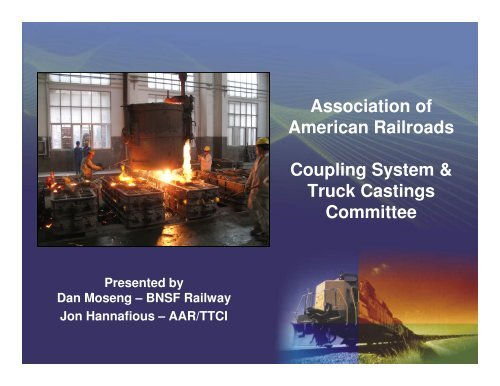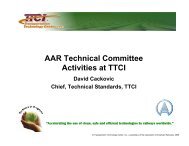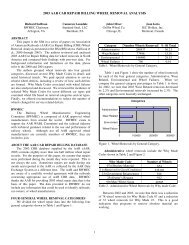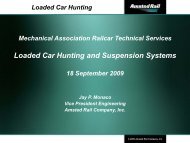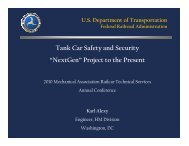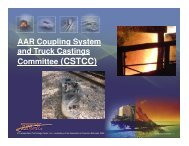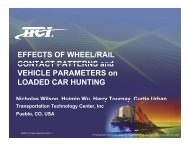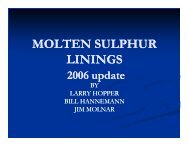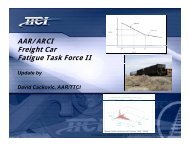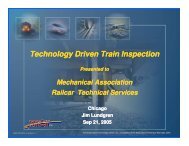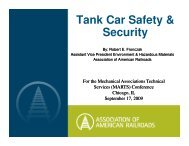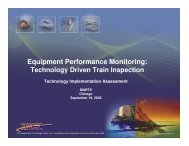Association of American Railroads Coupling System ... - Marts-rail.org
Association of American Railroads Coupling System ... - Marts-rail.org
Association of American Railroads Coupling System ... - Marts-rail.org
Create successful ePaper yourself
Turn your PDF publications into a flip-book with our unique Google optimized e-Paper software.
<strong>Association</strong> <strong>of</strong><br />
<strong>American</strong> <strong>Railroads</strong><br />
<strong>Coupling</strong> <strong>System</strong> &<br />
Truck Castings<br />
Committee<br />
Presented by<br />
Dan Moseng – BNSF Railway<br />
Jon Hannafious – AAR/TTCI<br />
1
Today’s Discussion<br />
◆ <strong>Coupling</strong> <strong>System</strong> and Truck Castings Committee<br />
◆ New Specification M-220: Casting NDT<br />
● Qualification Method For NDT Spec<br />
◆ New Specification M-216: Knuckle Fatigue Test<br />
◆ Summary <strong>of</strong> Other New Specifications or Those<br />
Undergoing Change<br />
◆ Suspension Component Failure<br />
◆ Questions and answers<br />
TM<br />
© TTCI/AAR, 2008 2
<strong>Coupling</strong> <strong>System</strong> and Truck Castings Committee<br />
◆ Committee members<br />
● Dan Moseng – BNSF – Chairman<br />
● Tim Ward – NS – Vice Chairman<br />
● Randy Gaston – UP<br />
● Kim Bowling – CSX<br />
● Rick Brueckert – TTX – AAB Representative<br />
● Mickey Clark – ASF – AAB Representative<br />
● Jon Hannafious – Committee Manager, AAR/TTCI<br />
TM<br />
© TTCI/AAR, 2008 3
<strong>Coupling</strong> <strong>System</strong> and Truck Castings Committee<br />
◆ Promotes policies, practices and procedures that will<br />
maintain/improve supplier casting practices and promote<br />
new and improved products for the <strong>rail</strong>road industry<br />
TM<br />
© TTCI/AAR, 2008 4
<strong>Coupling</strong> <strong>System</strong> and Truck Castings Committee<br />
◆ Responsible for about 70 AAR Standards, Specifications, and<br />
Recommended Practices pertaining to castings in MSRP Sections:<br />
● S – Casting Details<br />
● S-II – Truck Details and Casting Codes<br />
● S-III – Coupler and Yoke Details<br />
● Indirect Responsibility for some Specifications in Sections D and B<br />
◆ Supports 9 AAR Field Manual Interchange Rules<br />
covering couplers and castings<br />
● Rule 16 – Couplers, Type E and Parts<br />
● Rule 17 – Couplers, Type E/F and Parts<br />
● Rule 18 – Couplers, Type F and Parts<br />
● Rule 19 – Yokes, Type E<br />
● Rule 20 – Yokes, Type E/F and F<br />
● Rule 22 – Uncoupling Levers<br />
● Rule 47 – Truck Bolsters<br />
● Rule 48 – Truck Side Frames, Transoms, and Spring Planks<br />
● Rule 82 – Welding and Associated Heat Treatment<br />
TM<br />
© TTCI/AAR, 2008 5
<strong>Coupling</strong> <strong>System</strong> and Truck Castings Committee<br />
◆ Approves:<br />
● Side Frames & Bolsters<br />
● Couplers, Yokes, Knuckles, Follower Blocks<br />
● Uncoupling Levers<br />
● Foundries for Casting <strong>of</strong> Products listed above<br />
● Reconditioning Shops (M-212 & M-214)<br />
◆ Monitors Industry Failures & Addresses<br />
Casting Failure Issues<br />
TM<br />
© TTCI/AAR, 2008 6
New or Modified Specifications<br />
◆ New Specifications Planned for Release in 2008<br />
◆<br />
●<br />
●<br />
M-220 – Casting Component NDT Requirements<br />
▼<br />
Magnetic Particle Inspection <strong>of</strong> Railroad Knuckles<br />
M-216 – Knuckle Fatigue Test<br />
Specification Modification – In Progress<br />
●<br />
●<br />
●<br />
●<br />
●<br />
●<br />
M-205 – Addition <strong>of</strong> Yoke Fatigue Test to Existing Static Test<br />
M-211 – Couplers and Yokes, AAR Approved – Purchase and Acceptance<br />
M-214 – Side Frames and Bolsters, Used and Reconditioned – Classification<br />
and Reconditioning<br />
M-212 Couplers and Yokes, Secondhand – Classification and Reconditioning<br />
M-217/218/219 Articulated Connectors<br />
M – ??? – Specification for “One-Piece Truck”<br />
TM<br />
© TTCI/AAR, 2008 7
Today’s Discussion<br />
◆ <strong>Coupling</strong> <strong>System</strong> and Truck Castings Committee<br />
◆ New Specification M-220: Casting NDT<br />
● Qualification Method For NDT Spec<br />
◆ New Specification M-216: Knuckle Fatigue Test<br />
◆ Summary <strong>of</strong> Other New Specifications or Those Undergoing Change<br />
◆ Suspension Component Failure<br />
◆ Questions and answers<br />
TM<br />
© TTCI/AAR, 2008 8
New Specification M-220 (Released September 19, 2008):<br />
Casting Component Nondestructive Testing<br />
◆ M-220 was developed to address a need for NDT <strong>of</strong> castings<br />
◆ The Main body describes AAR administrative requirements, and the<br />
appendices will have specific guidelines for various components<br />
◆ Appendix A has been completed: Magnetic Particle Inspection <strong>of</strong> Railroad<br />
Knuckles - Guidelines & Procedures<br />
◆ Other appendices will be added in the future with guidelines and<br />
procedures for NDT <strong>of</strong> other Components<br />
◆ AAR Strategic Research Initiatives at TTCI are investigating NDT<br />
techniques for side frames and bolsters. This will provide input for future<br />
specifications<br />
TM<br />
© TTCI/AAR, 2008 9
M-220 Appendix A: Guidelines & Procedures<br />
Magnetic Particle Inspection (MPI) <strong>of</strong> Railroad Knuckles<br />
◆<br />
◆<br />
Appendix A Includes:<br />
●<br />
●<br />
●<br />
●<br />
Requirements and Procedures for<br />
▼<br />
▼<br />
Manufacturers & reclamation<br />
shops<br />
Car repair shops, RIP tracks,<br />
and mobile operations<br />
Inspector Qualification<br />
Equipment & Supplies<br />
Causes for Rejection<br />
The AAR Field Manual will be<br />
revised to allow cause for knuckle<br />
removal using Magnetic Particle<br />
Testing.<br />
TM<br />
© TTCI/AAR, 2008 10
M-220 Appendix A: Guidelines & Procedures<br />
Magnetic Particle Inspection <strong>of</strong> Railroad Knuckles<br />
◆<br />
Who Will Be Required To Perform Knuckle MPI?<br />
●<br />
●<br />
Mandatory: Manufacturers and Reclamation Shops<br />
Optional: Car repair shops, RIP tracks, and mobile operations<br />
◆<br />
Inspector Qualification<br />
●<br />
●<br />
ASNT Level I or higher or equivalent AAR member corporate program<br />
An ASNT Level III pr<strong>of</strong>essional or equivalent AAR member pr<strong>of</strong>essional must<br />
approve the training<br />
TM<br />
© TTCI/AAR, 2008 11
M-220 Appendix A: MPI Equipment & Supplies<br />
◆ Electromagnetic AC yoke<br />
◆ Dry powder magnetic particles<br />
◆ White powder liquid penetrant spray developer<br />
◆ Mandatory for field inspections & reclamation facilities<br />
◆ Not required for manufacturers<br />
◆ Magnetic particle field indicator (pie gauge)<br />
◆ Light source providing minimum <strong>of</strong> 50 foot candles<br />
◆ Lint-free rags<br />
◆ Cleaner<br />
◆ Ruler/tape measure accurate to 1⁄16 in.<br />
TM<br />
© TTCI/AAR, 2008 12
M-220 Appendix A: Causes for Rejection<br />
◆<br />
◆<br />
Car repair shops, RIP tracks, and mobile<br />
operations<br />
● Cracks greater than 1/4 in. long<br />
● For knuckles containing defects, we will<br />
refer to Rule 16, 17, or 18<br />
Manufacturer and Reclamation<br />
Inspections<br />
● Knuckles must be free <strong>of</strong> surface<br />
cracks, and surface discontinuities (hot<br />
tears, inclusions, porosity) with width,<br />
length, or depth dimensions greater<br />
than 1/8 in.<br />
● A grouping <strong>of</strong> five or more pin holes<br />
within a 1 in. 2 area and 3/16 in. or<br />
greater deep individual pin holes greater<br />
than 1/16 in. in diameter and greater<br />
than 3/16 in. deep<br />
TM<br />
© TTCI/AAR, 2008 13
M-220: Knuckle Inspection Procedures for Car Repair<br />
Shops, RIP tracks, and Mobile Operations<br />
◆ Visually inspect knuckle, including the flag hole<br />
◆ Clean the pulling face area <strong>of</strong> the knuckle, and visually inspect<br />
after cleaning<br />
◆ Spray developer onto the pulling face area <strong>of</strong> the knuckle<br />
◆ Position the yoke at knuckle placement #1 and energize<br />
◆ Apply the dry magnetic particles<br />
◆ Examine the knuckle for any accumulations <strong>of</strong> magnetic<br />
powder at flux leakage areas<br />
◆ Repeat for knuckle placements # 2 and # 3<br />
◆ Clean the the knuckle to remove magnetic particle dust and<br />
developer<br />
TM<br />
© TTCI/AAR, 2008 14
M-220: Knuckle Inspection Procedures for Car Repair<br />
Shops, RIP tracks, and Mobile Operations<br />
◆<br />
Three yoke placements to look for<br />
vertical cracks in the pulling face<br />
TM<br />
© TTCI/AAR, 2008 15
M-220: Knuckle Inspection Procedures for Car Repair<br />
Shops, RIP tracks, and Mobile Operations<br />
TM<br />
© TTCI/AAR, 2008 16
M-220: Knuckle Inspection: Additional Information and<br />
Procedures for Manufacturers & Reclamation Shops<br />
◆<br />
◆<br />
◆<br />
Two additional placements to look for<br />
horizontally oriented defects<br />
A recently sand- or shot-blasted surface<br />
is acceptable for inspection<br />
The use <strong>of</strong> developer is not mandatory<br />
TM<br />
© TTCI/AAR, 2008 17
Today’s Discussion<br />
◆ <strong>Coupling</strong> <strong>System</strong> and Truck Castings Committee<br />
◆ New Specification M-220: Casting NDT<br />
● M-220 Magnetic Particle Technique Qualification<br />
(Hannafious)<br />
◆ New Specification M-216: Knuckle Fatigue Test<br />
◆ Summary <strong>of</strong> Other New Specifications or Those Undergoing Change<br />
◆ Suspension Component Failure<br />
◆ Questions and answers<br />
TM<br />
© TTCI/AAR, 2008 18
M-220 Magnetic Particle Technique Qualification<br />
◆ Objective<br />
● To determine the capability <strong>of</strong> the dry magnetic particle method to<br />
detect linear indications greater than 0.250-inches in length in<br />
accordance with <strong>Association</strong> <strong>of</strong> <strong>American</strong> <strong>Railroads</strong> Specification<br />
M-220<br />
▼ For car repair shops, RIP tracks, and mobile operations<br />
● Compare results to the capability <strong>of</strong> conducting visual inspections<br />
currently utilized<br />
TM<br />
© TTCI/AAR, 2008 19
M-220 Magnetic Particle Technique Qualification<br />
◆ Approach<br />
● The M-220 MT technique was evaluated using “probability<br />
<strong>of</strong> detection” (POD), a proven method for procedure<br />
qualification<br />
● Performed a POD with 36 flawed and 24 unflawed knuckles<br />
● Four industry participants participated in the POD<br />
evaluations (BNSF, UPRR, NS, and TTX)<br />
TM<br />
© TTCI/AAR, 2008 20
M-220 Magnetic Particle Technique Qualification<br />
◆ TTCI Approach<br />
● Provided one day <strong>of</strong> industry training and one day <strong>of</strong><br />
inspection (POD subset)<br />
● Calculated individual and combined PODs<br />
TM<br />
© TTCI/AAR, 2008 21
M-220 Magnetic Particle Technique Qualification<br />
60 Knuckles Prepared for Inspection in Shop<br />
TM<br />
© TTCI/AAR, 2008 22
M-220 Magnetic Particle Technique Qualification<br />
◆ Magnetic Test to Visual Test Results Comparison<br />
● Lowest MT “Hit” result is greater than highest VT<br />
● MT false calls less than 10% in all cases<br />
TM<br />
© TTCI/AAR, 2008 23
M-220 Qualification: MT to VT Results Comparison<br />
◆ MT hit near 90% vs. VT at 75%, MT false call rate less than 10%<br />
◆<br />
MT demonstrated a higher capability than VT in detecting linear<br />
indications greater than 0.10-inches and achieved a near 100% POD<br />
TM<br />
© TTCI/AAR, 2008 24
Today’s Discussion<br />
◆ <strong>Coupling</strong> <strong>System</strong> and Truck Castings Committee<br />
◆ New Specification M-220: Casting NDT<br />
● Qualification Method For NDT Spec<br />
◆ New Specification M-216: Knuckle Fatigue Test (Moseng)<br />
◆ Summary <strong>of</strong> Other New Specifications or Those Undergoing Change<br />
◆ Suspension Component Failure<br />
◆ Questions and answers<br />
TM<br />
© TTCI/AAR, 2008 25
◆ Fatigue Test for Type E and Type F Knuckles<br />
◆ Includes<br />
● Test machine requirements<br />
● Load spectrum<br />
New Specification M-216<br />
Release Planned for 2008<br />
● Reporting requirements<br />
TM<br />
© TTCI/AAR, 2008 26
New Specification M-216 – Fatigue Test for Type E and<br />
Type F Knuckles<br />
◆ A test for evaluating the fatigue life<br />
<strong>of</strong> knuckles<br />
◆ Utilizes a known load spectra as<br />
measured in revenue service<br />
◆ Consideration was given to knuckle<br />
test results accumulated over the<br />
past 10 years<br />
◆ Was put out for industry comment<br />
via Circular Letter on 12/19/06, and<br />
after much consideration and slight<br />
modification was recently agreed to<br />
by manufacturers and CSTCC<br />
◆ Requires fatigue testing <strong>of</strong> four<br />
knuckles in addition to the static<br />
testing defined in AAR<br />
Specification M-211.<br />
TM<br />
© TTCI/AAR, 2008 27
New Specification M-216 – Knuckle Fatigue Test<br />
Load Cycles: Repeat to Failure <strong>of</strong> the Knuckle. 1,058 cycles<br />
are equivalent to approx. 1,000 miles<br />
Segment<br />
Number <strong>of</strong><br />
Cycles<br />
(Sinusoidal<br />
form)<br />
Total<br />
Elapsed<br />
Cycles<br />
Cycle Load<br />
Range<br />
1 4 4 10 – 300 kips<br />
2 2 6 10 – 280 kips<br />
3 7 13 10 – 260 kips<br />
4 10 23 10 – 240 kips<br />
5 31 54 10 – 220 kips<br />
6 77 131 10 – 200 kips<br />
7 65 196 10 – 180 kips<br />
8 73 269 10 – 160 kips<br />
9 89 358 10 – 140 kips<br />
10 105 463 10 – 120 kips<br />
11 129 592 10 – 100 kips<br />
12 187 779 10 – 80 kips<br />
13 279 1058 10 – 60 kips<br />
Norfolk Southern load frame used<br />
to test knuckles and coupler<br />
bodies.<br />
TM<br />
© TTCI/AAR, 2008 28
New Specification M-216 – Knuckle Fatigue Test<br />
Total Cycles to Failure<br />
Historical test result, plotted below, were<br />
used as a guideline for the new<br />
specification<br />
1200000<br />
1000000<br />
800000<br />
600000<br />
400000<br />
200000<br />
Knuckle Fatigue Test Results (NS Test Fixture)<br />
Average <strong>of</strong> 4 Tests Must Be Above 600,000<br />
No Test May Be Below 400,000 Cycles<br />
◆ The average life <strong>of</strong> the<br />
four knuckles tested<br />
must exceed 600,000<br />
cycles No individual<br />
knuckle to exhibit a life<br />
below 400,000 cycles<br />
◆ Goal <strong>of</strong> the CSTCC is to<br />
eliminate the poorest<br />
performing knuckles,<br />
and to bring up the<br />
average performance<br />
0<br />
0 1 2 3 4 5<br />
Foundry<br />
TM<br />
© TTCI/AAR, 2008 29
Today’s Discussion<br />
◆ <strong>Coupling</strong> <strong>System</strong> and Truck Castings Committee<br />
◆ New Specification M-220: Casting NDT<br />
● Qualification Method For NDT Spec<br />
◆ New Specification M-216: Knuckle Fatigue Test<br />
◆ Summary <strong>of</strong> Other New Specifications or Those Undergoing<br />
Change<br />
◆ Suspension Component Failure<br />
◆ Questions and answers<br />
TM<br />
© TTCI/AAR, 2008 30
Modified Specification M-211 – Couplers and Yokes,<br />
AAR Approved – Purchase and Acceptance<br />
◆ A draft for this specification has been completed. M-211<br />
finishing standards will be significantly strengthened in a<br />
manner similar to M-210.<br />
● Welding & Weld Repair<br />
● Tracking and Traceability<br />
◆ M-211 should be released by January 2009 for comment.<br />
TM<br />
© TTCI/AAR, 2008 31
Modified Specification M-214 Side Frames and Bolsters,<br />
Used and Reconditioned – Classification and Repair<br />
Procedure<br />
◆ A TAG was formed with CSTCC and the Truck<br />
Component Reconditioner <strong>Association</strong> to update<br />
and strengthen M-214. Work is complete, draft is<br />
in final edit<br />
◆ An updated M-214 will go out for Comment in<br />
early 2009<br />
TM<br />
© TTCI/AAR, 2008 32
Modified Specification M-205 – Yoke, Coupler – Test<br />
Requirements: Objectives<br />
◆ Objective: Improve yoke casting quality and<br />
reliability.<br />
◆ Add a fatigue test requirement to test for<br />
casting conditions not identified in the static<br />
tests<br />
◆ Review and update the current specification as<br />
needed (admin, static test procedures and<br />
loads, etc.)<br />
TM<br />
© TTCI/AAR, 2008 33
Modified Specification M-212 – Couplers and Yokes,<br />
Secondhand – Classification and Reconditioning<br />
◆ Objective: Improve coupler reconditioning quality<br />
and reliability. Focus will be on areas with known<br />
failures and other problems.<br />
◆ Work is just beginning.<br />
TM<br />
© TTCI/AAR, 2008 34
New Specifications – M-217/218/219 (Articulated<br />
Connectors)<br />
◆ Objective:<br />
● Improve articulated connector casting quality and reliability<br />
◆ A TAG has been formed with CSTCC and suppliers to<br />
create:<br />
● M-217 will be the manufacturing and acceptance<br />
specification<br />
● M-218 will be a test specification using the draft M-205<br />
(Yoke Test) basic layout<br />
● M-219 will be for reconditioning<br />
TM<br />
© TTCI/AAR, 2008 35
Today’s Discussion<br />
◆ <strong>Coupling</strong> <strong>System</strong> and Truck Castings Committee<br />
◆ New Specification M-220: Casting NDT<br />
● Qualification Method For NDT Spec<br />
◆ New Specification M-216: Knuckle Fatigue Test<br />
◆ Summary <strong>of</strong> Other New Specifications or Those Undergoing Change<br />
◆ Suspension Component Failure (Hannafious)<br />
◆ Questions and answers<br />
TM<br />
© TTCI/AAR, 2008 36
Casting Suspension Component Failure Locations<br />
2<br />
7<br />
34<br />
1 56<br />
4.5<br />
4<br />
3.5<br />
3<br />
T<strong>rail</strong>ing 1 Year Window, Failures Per Year<br />
2.5<br />
2<br />
1.5<br />
1<br />
0.5<br />
0<br />
2<br />
1/1/05 1/1/06 1/1/07 1/1/08 12/31/08<br />
TM<br />
© TTCI/AAR, 2008 37
Component Failure Example 1<br />
◆ Break initiated at internal rib<br />
◆ Initiation site was weld with inclusions<br />
TM<br />
© TTCI/AAR, 2008 38
Component Failure Example 2<br />
◆ Break initiated at internal rib<br />
◆ Initiation site was likely a torch wash (martensite)<br />
TM<br />
© TTCI/AAR, 2008 39
Component Failure Fact Summary<br />
◆ All were brittle failures (no signs <strong>of</strong> fatigue) manufactured in 2003<br />
and 2004 - inspection could not identify cracks, there were none<br />
◆ No full de<strong>rail</strong>ments occurred<br />
◆ Castings met static AAR load requirements<br />
◆ Casting material met mechanical property requirements<br />
◆ Some signs <strong>of</strong> thin walls on casting, but nothing major<br />
◆ As compared to the previous failure issues, decision on what to do<br />
was more difficult, as previous issue components did not meet AAR<br />
specifications<br />
◆ Though martensite was found on some failures, it was allowed at the<br />
time – Specifications have been changed since that time, that would<br />
have caused these castings to be Re-heat-treated.<br />
TM<br />
© TTCI/AAR, 2008 40
Component Failure Risk Assessment<br />
◆ Data and investigations did not provide CSTCC with a<br />
primary cause and therefore no solution<br />
◆ Undertook a risk assessment this year to provide<br />
direction<br />
◆ Risk Assessment would allow CSTCC to select the lower<br />
projected cost <strong>of</strong> two options:<br />
● Cost <strong>of</strong> being passive (15 year NPV <strong>of</strong> allowing components to<br />
remain in service, assuming a number <strong>of</strong> them would fail each<br />
year, and costs are associated with the cleanup)<br />
● Cost <strong>of</strong> removing components from service now<br />
TM<br />
© TTCI/AAR, 2008 41
Component Failure Risk Assessment<br />
◆ Assumptions:<br />
● All castings made in 2003 and 2004 were suspect (11,000 and<br />
22,000 respectively)<br />
● Castings were installed in cars, and those cars were categorized<br />
by four levels <strong>of</strong> hazard based on the commodity being<br />
transported<br />
● Those hazard levels could be associated with the cost <strong>of</strong><br />
de<strong>rail</strong>ment<br />
● Half <strong>of</strong> all failures would result in de<strong>rail</strong>ment, and product would<br />
be released in 9% <strong>of</strong> all de<strong>rail</strong>ments<br />
TM<br />
© TTCI/AAR, 2008 42
Component Failure Risk Assessment<br />
Number <strong>of</strong> Cars with Suspect Castings (Assumed)<br />
Manufactured in 2003-2004<br />
16000<br />
14000<br />
14579<br />
12000<br />
Number <strong>of</strong> Cars<br />
10000<br />
8000<br />
6000<br />
4000<br />
2000<br />
0<br />
516<br />
992<br />
413<br />
High Medium Low Minimal / None<br />
Hazard Level <strong>of</strong> Commodity<br />
TM<br />
© TTCI/AAR, 2008 43
Component Failure Risk Assessment<br />
Costs ($)<br />
$58,000,000<br />
$10,000,000<br />
Break Even: Compare the Costs <strong>of</strong> Being Passive with the<br />
Costs <strong>of</strong> Removing Castings Now.<br />
$9,000,000<br />
$8,000,000<br />
$7,000,000<br />
$6,000,000<br />
$5,000,000<br />
$4,000,000<br />
$3,000,000<br />
$2,000,000<br />
$1,000,000<br />
$0<br />
1 2 3 4 5 6<br />
Expected Number <strong>of</strong> Casting Failures per Year<br />
Cost <strong>of</strong> Being Passive - High Hazard<br />
Cars<br />
Cost <strong>of</strong> Being Passive - Medium<br />
Hazard Cars<br />
Cost <strong>of</strong> Being Passive - Low Hazard<br />
Cars<br />
Cost <strong>of</strong> Being Passive - Non Hazard<br />
Cars<br />
Replacement Cost, High Hazard Cars<br />
Replacement Cost, Medium Hazard<br />
Cars<br />
Replacement Cost, Low Hazard Cars<br />
Replacement Cost, Non Hazard Cars<br />
TM<br />
© TTCI/AAR, 2008 44
Component Failure - Risk Assessment<br />
◆ CSTCC concluded that we take action if the number <strong>of</strong><br />
casting failures climbs to four per year<br />
● Then will remove castings from approximately 500<br />
high hazard cars<br />
◆ CSTCC awaiting decision higher level AAR Committee<br />
TM<br />
© TTCI/AAR, 2008 45
Today’s Discussion<br />
◆ <strong>Coupling</strong> <strong>System</strong> and Truck Castings Committee<br />
◆ New Specification M-220: Casting NDT<br />
● Qualification Method For NDT Spec<br />
◆ New Specification M-216: Knuckle Fatigue Test<br />
◆ Summary <strong>of</strong> Other New Specifications or Those<br />
Undergoing Change<br />
◆ Suspension Component Failure<br />
◆ Questions and answers<br />
TM<br />
© TTCI/AAR, 2008 46


